Nyheter
Why Are DEXs the Undisputed Game-Changer of Modern Digital Finance?
Publicerad
7 månader sedanden
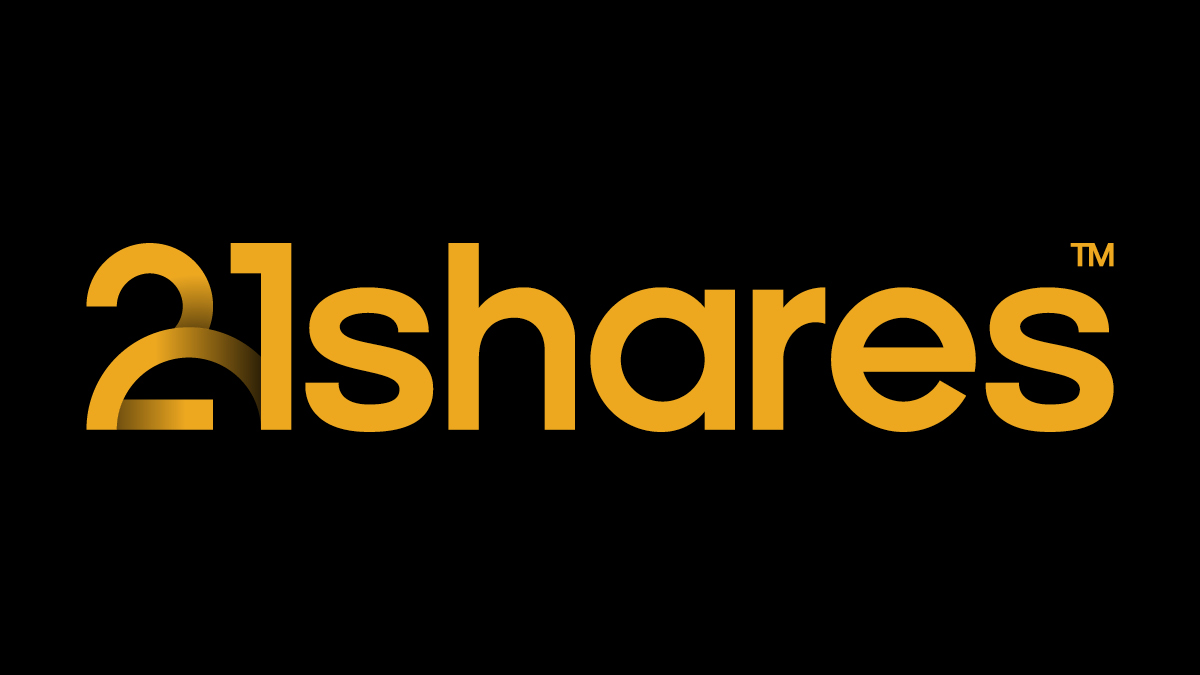
The decentralized finance (DeFi) sector is poised for explosive growth, with estimates projecting at least an $80B valuation by the end of 2025. This remarkable trajectory is fueled by a confluence of factors, including favorable regulatory shifts and the pivotal role of decentralized exchanges (DEXs) in driving market trends. At the heart of the DeFi landscape are four key exchanges that exemplify the sector’s dynamism and potential:
- Uniswap: The industry titan with multi-chain dominance
- Aerodrome: Base network’s powerhouse
- Raydium: Solana’s DeFi cornerstone
- Jupiter: The innovative aggregator reshaping Solana’s ecosystem
Why focus on these exchanges now? The DeFi sector is at a critical juncture:
• Imminent protocol upgrades promise to reshape market dynamics.
• Institutional participation is surging, driven by regulatory clarity.
• The Total Value Locked (TVL) in DeFi is expected to surpass $250B by year-end.
• DEXs are playing a crucial role in emerging trends, including the rise of memecoins, AI agents and tokenized real-world assets.
As we delve into these four pivotal exchanges, we’ll uncover the technological advancements, market strategies, and regulatory adaptations that are set to define DeFi’s trajectory in 2025 and beyond.
For starters, what are Decentralized Exchanges (DEXs)?
DEXs are non-custodial exchanges empowering users to trade assets directly via self-executing smart contracts, bypassing traditional intermediaries. By linking non-custodial wallets like MetaMask and Phantom, traders retain full control of their funds while swapping tokens across different blockchains. Instead of centralized order books, DEXs leverage automated market makers (AMMs)—algorithmic liquidity pools that set prices and enable anyone to contribute capital, democratizing market access for both users and liquidity providers. As seen below, the ratio of volume between decentralized vs. centralized venues has reached its highest level to date.
Figure 1: Decentralized to Centralized Exchange Spot Volumes

Source: 21Shares, TheBlock
Why are DEXs important?
DEXs dismantle financial gatekeepers, democratizing access through unstoppable, open-source protocols that fuel permissionless innovation. Unlike centralized giants like Mt. Gox or Bitfinex—whose catastrophic hacks exposed systemic fragility—DEXs are immune to single-point failures due to the decentralized nature of their underlying networks. Their censorship-resistant design ensures no entity can freeze assets or halt transactions. For example, the SEC sent a Wells notice to Uniswap Labs alleging they’re facilitating the trading of unregistered securities. While the foundation removed the tokens from its front end, the underlying smart contracts remained accessible on Ethereum. This meant that users could still interact with these tokens through alternative front-ends or by directly engaging with underlying smart contracts. This reinforces that while regulators target surface-level interfaces, the core infrastructure remains immutable—a testament to DeFi’s immutable foundational promise.
Having said that, aggregators also play an important role. Just as brokerage platforms consolidate fragmented liquidity across centralized exchanges, DEX aggregators in crypto fulfill a similar role. These tools optimize trade execution by intelligently routing orders, reducing slippage and costs by 2-5%. Working symbiotically with DEXs like Uniswap, aggregators drive 20-35% of DEX volume, creating a win-win ecosystem: DEXs gain increased activity, while aggregators thrive on consolidated liquidity. This collaboration transforms isolated pools into a cohesive financial network.
Why are we talking about them now?
For one, DeFi ranks among the highest revenue-generating sectors in the crypto ecosystem, as seen in Figure 2. This stems from DeFi’s early maturity and its strong Product-Market Fit due to its vital role in enabling access to emerging sectors.
Figure 2: Breakdown of the top 20 revenue-generating protocols, categorized by sectors, over the last year.
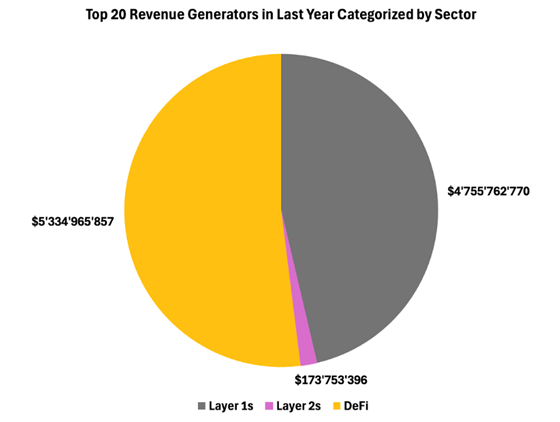
Source: 21Shares, TokenTerminal
Specifically, DEXs dominate blockchain activity as the primary gas consumers, with platforms like Uniswap and Raydium consistently ranking as top spenders across the landscape, as seen in Figure 3. Furthermore, exchanges have a symbiotic relationship with stablecoins: over half of Tether’s on-chain transactions originate from trading, creating a self-reinforcing cycle where Tether liquidity fuels DEX volume. At the same time, DEX demand solidifies Tether’s dominance. By driving 60-75% of on-chain activity through token swaps, stablecoin demand, and dApp liquidity provision, exchanges act as a foundational access point for the crypto ecosystem.
Figure 3: Top 10 Gas Spenders in Last Year
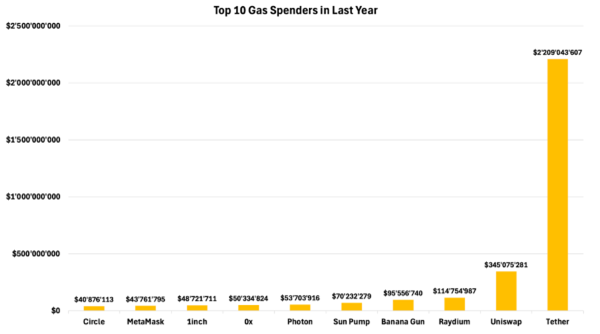
Source: 21Shares, TokenTerminal
In a sense, DEXs not only drive their own ecosystem but also generate a significant portion of the demand for the underlying blockchains they operate on. However, they can capture even more value and strengthen the investment case for their native tokens by positioning them as the gas token for their dApp. Given the self-reinforcing ecosystem and user loop they create, it becomes increasingly logical for DEXs to evolve into their own app-chains—allowing them to fully internalize transaction fees, optimize performance, and enhance user experience while maintaining sovereignty over their liquidity and trading infrastructure.
We are seeing this starting to materialize, both with Uniswap’s Unichain, which we wrote an entire previous newsletter on, and Jupiter’s Jupnet. The latter is a new omnichain network aiming to unify liquidity across multiple blockchains into one platform, creating a decentralized ledger that enhances usability for both users and developers. Jupnet envisions a future where a single account can seamlessly access all chains, currencies, and commodities—referred to as the ”1A3C” vision. This approach is designed to simplify blockchain interactions while empowering new innovations in cross-chain liquidity and usability.
The evolution of Uniswap and Jupiter into application-specific chains represents a strategic shift in the DeFi landscape driven by similar motivations. Both protocols aim to optimize their ecosystems by vertically integrating their operations. Uniswap’s upcoming Unichain and Jupiter’s cross-chain network are designed to significantly reduce fees, enhance trading speeds, and consolidate fragmented liquidity across multiple chains. In addition, it also creates new revenue streams by capturing MEV —estimated at over $400M annually—that previously leaked to third parties. By internalizing these value streams, both protocols transform from mere liquidity providers into self-sustaining trading ecosystems while building defensible moats against competitors
Beyond this strategic shift, Uniswap is also setting itself up for success with the release of v4, which was just deployed this week. The latest upgrade enhances v3’s efficiency with optimizable adapters that enable custom logic during swaps, liquidity actions, or fee collection. This modular design supports advanced features like limit orders, dynamic fees, and automated liquidity management without core protocol changes. Traders and liquidity providers benefit from reduced costs and flexible fee structures that optimize value distribution.
DEX Memecoin Frenzy
The surge in non-custodial infrastructure adoption has been significantly propelled by memecoins, offering an accessible gateway for newcomers to the crypto ecosystem, especially as these tokens are often unavailable on centralized exchanges during their initial launch. This trend has been a major catalyst for DEX growth over the past year, peaking with Trump’s memecoin launch. A prime example is Raydium, Solana’s largest DEX, where memecoin trading dominates activity. In the last 24 hours, memecoins represented 7 of the top 10 most traded tokens on the platform, accounting for over 30% of its total volume. Expanding this view, 41 of the top 50 traded tokens were memecoins, contributing to more than 50% of Raydium’s daily trading volume. These statistics underscore the pivotal role of memecoin speculation in driving DEX activity and liquidity in decentralized markets.
Figure 4: Raydium 24-Hour Spot Trading Volume

Source: 21Shares, Coingecko
$TRUMP, World Liberty Financial (WLFI) Convergence, What’s Next?
The Trump ecosystem appears poised to expand its crypto footprint. Following their DeFi lending platform (WLF), a Trump-branded DEX could emerge as the logical next step—transforming TRUMP from a memecoin into the cornerstone of a self-sustaining DeFi network. Despite ranking 40th in market cap, TRUMP already claims a top-10 trading volume spot, signaling robust demand. A dedicated DEX would amplify this activity while unlocking fee-based revenue, solidifying Trump’s crypto influence through an integrated swap-lend-earn ecosystem.
Looking ahead, a Trump Layer 2 or appchain could elevate this vision. By designating TRUMP as the network’s native gas token, the ecosystem could internalize transaction fees, enhance scalability, and deepen token utility. Such a move would transcend memecoin status, potentially reshaping how public figures monetize digital influence and the overall perception of these tokens.
Having established the critical role of DEXs, let’s now explore the key factors that set them apart and their key value propositions:
Total Value Locked serves as DeFi’s primary metric for measuring capital deployed across protocols. Initially, Uniswap dominated this space by capitalizing on Ethereum’s first-mover advantage and network effects, reaching a peak TVL of $10B. Despite severe market fluctuations during recent crypto winters, DEX TVL remained stable – demonstrating DeFi’s market maturity and sustainable product-market fit.
Figure 5: Total Value Locked Across Major DEXs

Source: 21Shares, DeFiLlama
The competitive landscape has shifted significantly with new entrants challenging Ethereum’s dominance. Aerodrome leveraged Coinbase’s Base network integration to streamline user onboarding, while Solana’s low-cost infrastructure fueled growth of protocols like Raydium and Jupiter, which now collectively hold over $5B in TVL. These developments reduced Uniswap’s market share from near-total dominance to roughly 50% of the combined TVL held by these three emerging rivals. This redistribution highlights DeFi’s evolution into a multi-chain ecosystem where scalability and user experience increasingly dictate platforms’ success.
Daily active users follow a similar trend. Uniswap, benefiting from Ethereum’s ecosystem, once dominated but Solana-based apps, especially Raydium, surged. By late last year, Raydium captured over 80% of daily active users, driven by memecoin trading’s retail appeal.
Figure 6: Daily Active Users Across Major DEXs

Figure 7: Total Volume Across Major DEXs

Source: 21Shares, TokenTerminal, Artemis
Transaction counts also highlight the rapid growth of Solana-based platforms, particularly Raydium, driven by speculative trading and low costs. As shown in Figure 8, Raydium reached a peak of over 25M transactions in a single day, more than double its other competitors, showcasing its dominance in the current DEX landscape.
Figure 8: Total Transaction Count Across Major DEXs
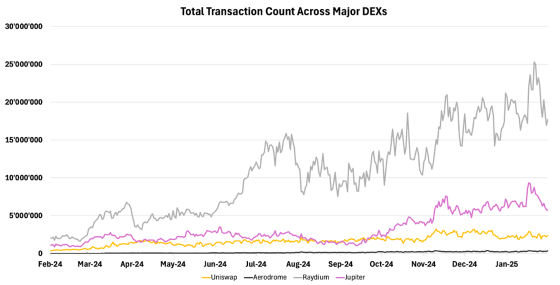
Source: 21Shares, Token Terminal, Dune
Figure 9 highlights that Raydium’s significant activity translates into equally notable revenue generation, making nearly $30M in revenue the weekend ahead of the inauguration. Meanwhile, Aerodrome generates substantial revenue due to the vote-escrow mechanism which is explored in a later section.
Figure 9: Total Revenue Generated

Source: 21Shares, TokenTerminal, Dune
For the technically curious, the following section delves deep into the intricacies that distinguish these DEXs.
Figure 10: Comparing the Different DEX Platforms
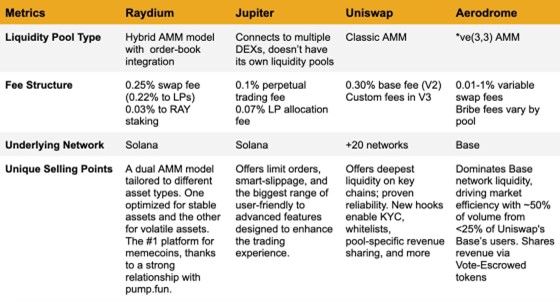
Source: 21Shares
The main differentiating feature amongst DEXs is how they operate their liquidity models. For example, Raydium’s Hybrid AMM model combines Concentrated Liquidity Market Maker (CLMM) with Central Limit Order Book (CLOB), offering both customizable liquidity ranges and traditional order matching. This model provides flexibility for traders and liquidity providers. Alternatively, Uniswap’s Classic AMM, maintains liquidity across all price points, ensuring continuous liquidity. However, this model may be less capital efficient and more rigid.
Finally, Aerodrome’s *ve(3,3) AMM, inspired by Curve Finance, introduces vote-escrowed tokens and bribes to incentivize liquidity provision. This model allows token holders to lock their tokens for voting rights and elevated rewards, potentially creating a more engaged and stickier liquidity base. As such, each model offers a unique balance between simplicity, capital efficiency, and user incentives.
To summarize, these are the key distinctions between all 4 models:
• Raydium offers customizable liquidity ranges and traditional order matching.
• Jupiter is an aggregator that lacks its own liquidity engine. However, it offers centralized exchange-level features like limit orders and dynamic slippage calculator,upgrading the typical DEX user-experience.
• Uniswap V3 pioneered concentrated liquidity, enabling roughly 4000x capital efficiency vs V2 in stablecoin pairs.
• Aerodrome uses Curve-style vote-escrow tokens (veAERO) with bribes directing 73% of revenue.
Having identified the differences between the platforms’ technologies, let’s compare the valuation of their respective tokens:
Figure 11: DEXs’ Tokens Valuation Metrics
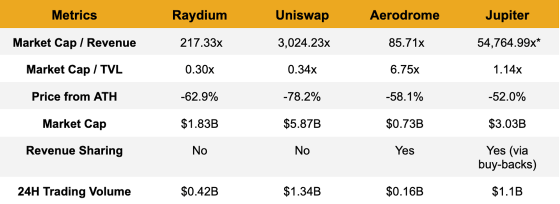
Source: 21Shares, TokenTerminal
*Jupiter’s revenue here only accounts for its spot market activity, although the bulk of its activity actually comes from its derivatives platform, that’s why it has such a seemingly unfavorable market cap / revenue ratio.
As seen, Aerodrome stands out as a remarkably undervalued token compared to its peers, driven by its impressive revenue generation and dominance on the Base network. Despite operating on a single chain and capturing less than 25% of Uniswap’s user base, Aerodrome’s performance underscores the power of strong product-market fit. Its success, particularly when compared to multi-chain platforms like Uniswap, highlights the potential for focused, chain-specific exchanges. In terms of Market Cap to TVL, Uniswap and Raydium’s low ratio suggest undervaluation, reflecting high capital efficiency and stronger usage. However, relative valuation is just one factor to consider, as these protocols are at varying stages of maturity. The evolving DeFi landscape suggests a future where multiple specialized exchanges can thrive simultaneously, each carving out its niche in the broader ecosystem.
All in all, DeFi emerges as a 2025 standout sector, fueled by regulatory tailwinds and accelerating institutional adoption of on-chain infrastructure. At its core, DEXs like Uniswap and Jupiter are evolving into critical infrastructure, leveraging innovations such as Unichain and Jupnet to achieve institutional-grade scalability while pioneering app-chain architectures. As the DEX/CEX volume ratio reaches record highs just shy of 40%, these platforms are uniquely positioned to capitalize on the migration to decentralized markets. Their growing emphasis on user-aligned tokenomics—where revenue-sharing mechanisms transform governance tokens into yield-generating assets—creates a compelling value proposition for investors navigating this new era of value accrual in DeFi.
What’s happening this week?
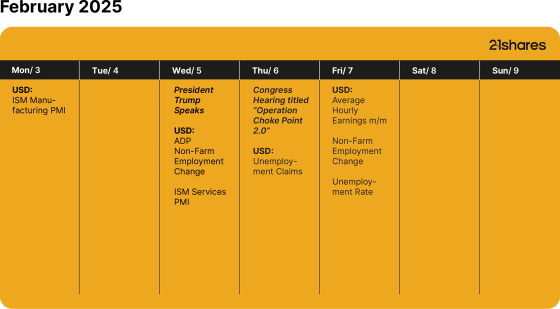
Research Newsletter
Each week the 21Shares Research team will publish our data-driven insights into the crypto asset world through this newsletter. Please direct any comments, questions, and words of feedback to research@21shares.com
Disclaimer
The information provided does not constitute a prospectus or other offering material and does not contain or constitute an offer to sell or a solicitation of any offer to buy securities in any jurisdiction. Some of the information published herein may contain forward-looking statements. Readers are cautioned that any such forward-looking statements are not guarantees of future performance and involve risks and uncertainties and that actual results may differ materially from those in the forward-looking statements as a result of various factors. The information contained herein may not be considered as economic, legal, tax or other advice and users are cautioned to base investment decisions or other decisions solely on the content hereof.
Du kanske gillar
-
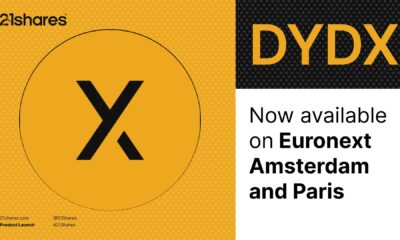

21Shares lanserar DYDX – Din port till decentraliserade perpetuals
-
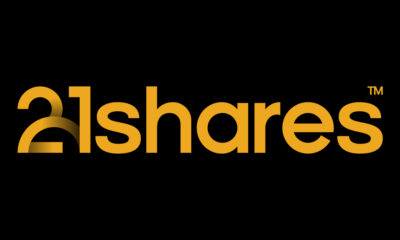

Concerned about rising government debt? Bitcoin’s got you covered
-
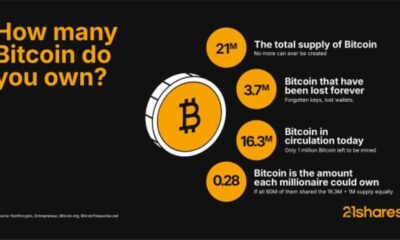

Bitcoin is scarce. Will you get your share?
-
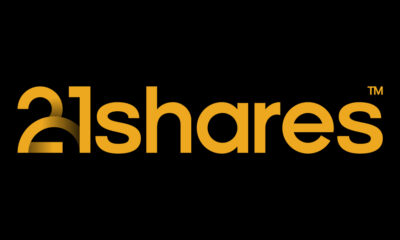

Bitcoin surpasses Alphabet and Amazon by market cap
-
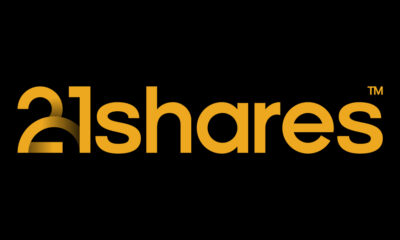

The Bitcoin boom hiding in Americans’ retirement savings
-


UK investors, are you ready for crypto ETNs?
Nyheter
IVAI ETF för den som tror på Artificiell intelligens
Publicerad
4 timmar sedanden
15 september, 2025
Invesco Artificial Intelligence Enablers UCITS ETF Acc (IVAI ETF) med ISIN IE000LGWDNE5, försöker spåra S&P Kensho Global Artificial Intelligence Enablers Screened index. S&P Kensho Global Artificial Intelligence Enablers Screened-index spårar resultatet för företag som har en distinkt del av sin verksamhet och intäkter som kommer från området artificiell intelligens. Aktierna som ingår filtreras enligt ESG-kriterier (miljö, social och bolagsstyrning).
Den börshandlade fondens TER (total cost ratio) uppgår till 0,35 % p.a. Invesco Artificial Intelligence Enablers UCITS ETF Acc är den enda ETF som följer S&P Kensho Global Artificial Intelligence Enablers Screened index. ETFen replikerar det underliggande indexets prestanda genom fullständig replikering (köper alla indexbeståndsdelar). Utdelningarna i ETFen ackumuleras och återinvesteras.
Invesco Artificial Intelligence Enablers UCITS ETF Acc är en mycket liten ETF med tillgångar på 2 miljoner euro under förvaltning. Denna ETF lanserades den 29 oktober 2024 och har sin hemvist i Irland.
Produktbeskrivning
Invesco Artificial Intelligence Enablers UCITS ETF Acc syftar till att tillhandahålla den totala nettoavkastningen för S&P Kensho Global Artificial Intelligence Enablers Screened Index (”Referensindexet”), minus avgifternas inverkan.
Värdepapper är exkluderade från ersättning för referensindex om de: 1) är involverade i tobak, kontroversiella vapen, oljesand, handeldvapen, militära kontrakt eller termiskt kol; 2) bedöms inte följa principerna i FN:s Global Compact, 3) ha ett ESG-poäng i de 10 % lägre av S&P Global BMI Index; eller 4) inte omfattas av ESG-datalösningen som används av Indexleverantören.
Företag utvärderas och väljs sedan ut om de av indexleverantören fastställs att de är fokuserade på att utveckla och möjliggöra tekniken, infrastrukturen och tjänsterna som driver tillväxten och funktionaliteten hos AI; specifikt inklusive dessa affärsaktiviteter: (a) hårdvara, inklusive chips och datorutrustning som stöder högpresterande AI-beräkningar och operationer; (b) mjukvaru- och lösningsutvecklare av AI-algoritmer och -produkter; (c) Infrastrukturtjänster som är integrerade för att möjliggöra dataintensiv AI-kapacitet. (d) produkter och tjänster som tillhandahåller ett ramverk specifikt för AI-tillämpningar, och (e) leverantörer av datakurering och hanteringslösningar som stöder effektiv utbildning och funktion av AI-modeller.
Företag klassificeras som antingen ”Core” (de med en betydande del av sin affärsverksamhet och/eller intäkter som härrör från produkter och tjänster i linje med temat) eller ”Icke-Core” (de som verkar över temats bredare värdekedja ), som bestäms av indexleverantören, och en överviktsfaktor tillämpas på gruppen av kärnvärdepapper för att öka den totala exponeringen mot dessa aktier och betona ren lekinnovation. Inom varje grupp är företagen lika viktade under förutsättning av diversifiering och likviditetsbegränsningar. Referensindexet balanserar om kvartalsvis.
Fonden strävar efter att uppnå sitt mål genom att köpa och hålla, så långt det är möjligt och praktiskt möjligt, samtliga aktier i referensindex i sina respektive vikter.
Denna ETF hanteras passivt
En investering i denna fond är ett förvärv av andelar i en passivt förvaltad, indexföljande fond snarare än i de underliggande tillgångarna som ägs av fonden.
Investeringsrisker
För fullständig information om risker, se de juridiska dokumenten. Värdet på investeringar, och eventuella intäkter från dem, kommer att fluktuera. Detta kan delvis bero på förändringar i valutakurser. Investerare kanske inte får tillbaka hela det investerade beloppet. Eftersom denna fond har en betydande exponering mot en eller ett litet antal sektorer bör investerare vara beredda att acceptera en högre grad av risk än för en ETF med ett bredare investeringsmandat.
Fonden kan vara exponerad för risken att låntagaren inte fullgör sin skyldighet att lämna tillbaka värdepapperen i slutet av låneperioden och att inte kan sälja de säkerheter som ställts till den om låntagaren fallerar. Fonden har för avsikt att investera i värdepapper från emittenter som hanterar sina ESG-exponeringar bättre i förhållande till sina jämförbara företag. Detta kan påverka fondens exponering mot vissa emittenter och få fonden att avstå från vissa investeringsmöjligheter.
Fonden kan prestera annorlunda än andra fonder, inklusive underpresterande andra fonder som inte försöker investera i värdepapper från emittenter baserat på deras ESG-betyg. Värdet på aktier och aktierelaterade värdepapper kan påverkas av ett antal faktorer, inklusive emittentens verksamhet och resultat samt allmänna och regionala ekonomiska och marknadsmässiga förhållanden. Detta kan leda till fluktuationer i fondens värde. Fonden kan vara exponerad för ett begränsat antal positioner vilket kan resultera i större fluktuationer i fondens värde än för en fond som är mer diversifierad. Fonden är investerad i en viss geografisk region, vilket kan leda till större fluktuationer i fondens värde än för en fond med ett bredare geografiskt investeringsmandat.
Handla IVAI ETF
Invesco Artificial Intelligence Enablers UCITS ETF Acc (IVAI ETF) är en europeisk börshandlad fond. Denna fond handlas på flera olika börser, till exempel Deutsche Boerse Xetra och London Stock Exchange.
Det betyder att det går att handla andelar i denna ETF genom de flesta svenska banker och Internetmäklare, till exempel DEGIRO, Nordnet, Aktieinvest och Avanza.
Börsnoteringar
| Börs | Valuta | Kortnamn |
| Borsa Italiana | EUR | IVAI |
| London Stock Exchange | GBX | IAIX |
| London Stock Exchange | USD | IVAI |
| SIX Swiss Exchange | CHF | IVAI |
| XETRA | EUR | IVAI |
Största innehav
| Namn | CUSIP | ISIN | Vikt % |
| ORACLE CORP USD0.01 | 68389X105 | US68389X1054 | 4.21% |
| C3.AI INC-A USD 0.0010 | 12468P104 | US12468P1049 | 4.04% |
| EXLSERVICE HOLDINGS INC USD0.001 | 302081104 | US3020811044 | 3.86% |
| KYNDRYL HOLDINGS INC-W/I USD 0.0100 | 50155Q100 | US50155Q1004 | 3.76% |
| SOUNDHOUND AI USD 0.000100000 | 836100107 | US8361001071 | 3.72% |
| DELL TECHNOLOGIES -C NPV | 24703L202 | US24703L2025 | 3.71% |
| AMBARELLA INC USD 0.0005 | G037AX101 | KYG037AX1015 | 3.67% |
| EPAM SYSTEMS INC USD0.001 | 29414B104 | US29414B1044 | 3.62% |
| ALTAIR ENGINEERING INC – A NPV | 021369103 | US0213691035 | 3.60% |
| NVIDIA CORP USD0.001 | 67066G104 | US67066G1040 | 3.51% |
Innehav kan komma att förändras
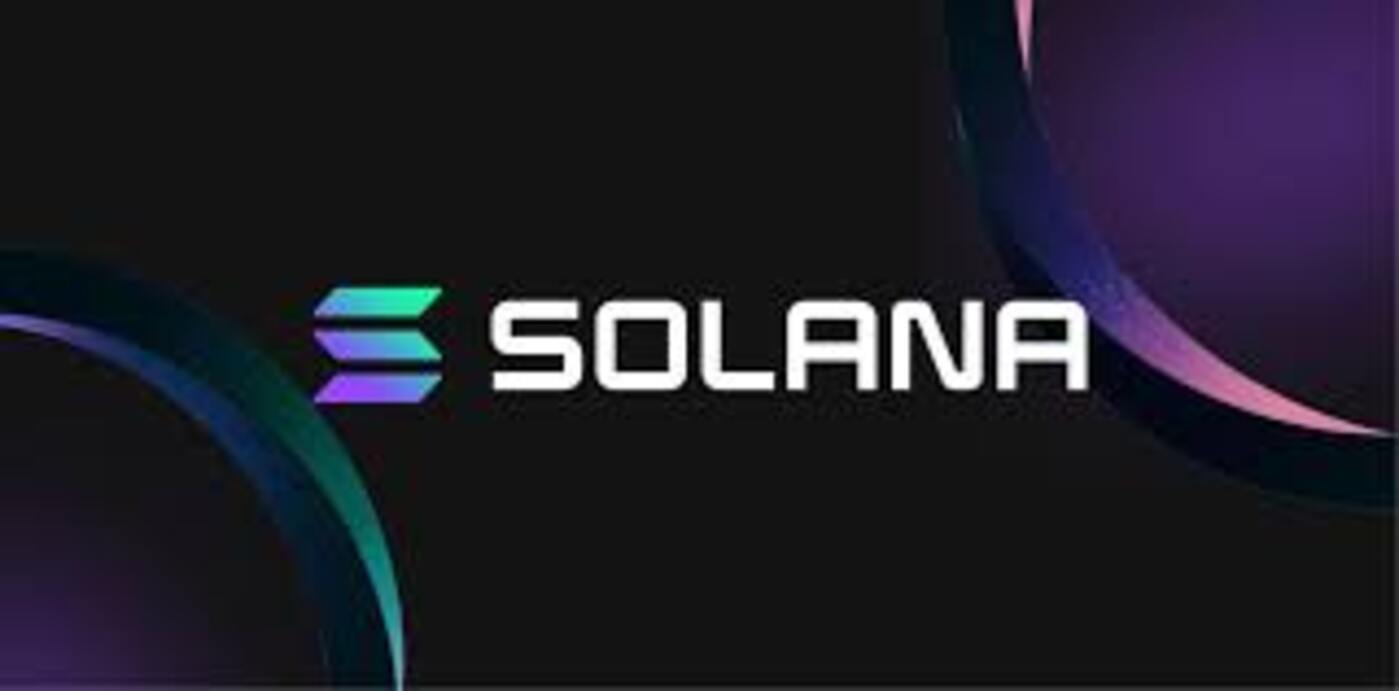
CoinShares XBT Physical Staked Solana (COINSOL ETP) med ISIN SE0024367114, är en fysiskt säkerställd krypto-ETP som är helt säkerställd av den underliggande tillgången Solana. Den gör det möjligt för investerare att säkert få exponering mot priset på Solana på en reglerad börs. Solana som innehas för COINSOLs räkning förvaras hos Komainu (Jersey) Limited och Zodia Custody Limited, reglerade institutionella förvaltare av digitala tillgångar.
Fondens kostnadskvot (ER) är 1,50 % per år. Den startade sin verksamhet den 21 maj 2025 och dess registreringsland är Sverige.
Produktinformation
| Namn | CoinShares XBT Phys Staked Solana – SEK |
| ISIN | SE0024367114 |
| Kortnamn | COINSOL |
| Avgift | 1,50 % |
| Basvaluta | SEK |
| Replikeringsmetod | Fysisk |
| Utdelningspolicy | Ackumulerande |
| Benchmarkindex | Compass Crypto Reference Solana |
| Aktivt förvaltad | Ja |
| Hemvist | Sverige |
| Lanseringsdatum | 21 maj 2025 |
| Emittent | XBT Provider |
Handla COINSOL ETP
CoinShares XBT Physical Staked Solana (COINSOL ETP) är en europeisk börshandlad produkt som handlas på bland annat Nasdaq Stockholm.
Det betyder att det går att handla andelar i denna ETP genom de flesta svenska banker och Internetmäklare, till exempel Nordnet, SAVR, Levler, DEGIRO och Avanza.
Börsnoteringar
| Börs | Valuta | Kortnamn |
| NASDAQ Stockholm | SEK | COINSOL |
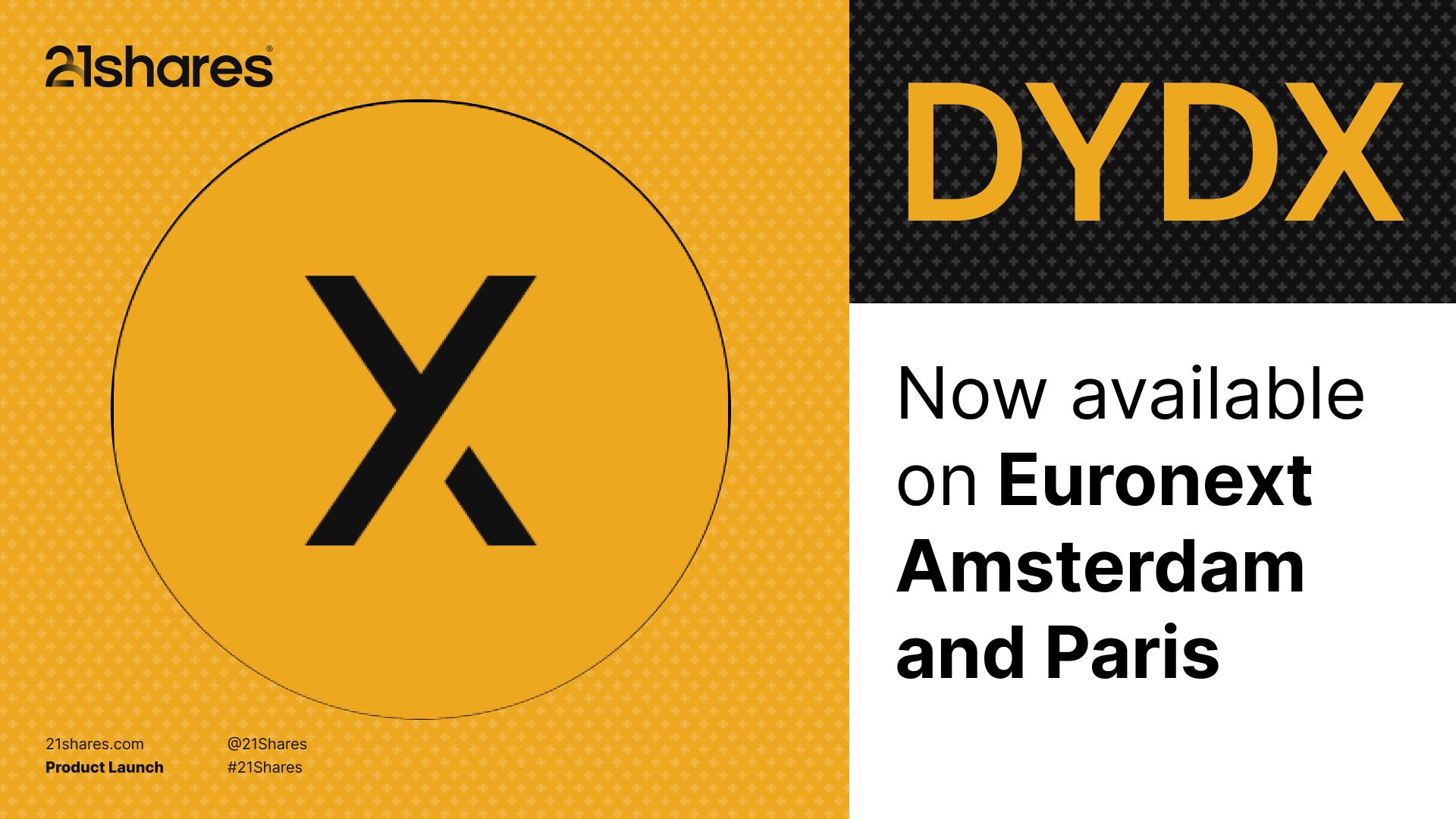
21Shares dYdX ETP (DYDX ETP) med ISIN CH1454621793, erbjuder investerare ett likvidt sätt att integrera ETPen, som spårar DYDX, i sina portföljer via sin bank eller mäklare, vilket ger ett transparent sätt att delta i framtidens decentraliserade kryptohandel.
Fördelar
Robust tokenomik som driver tillväxt
Protokollet kopplar plattformens prestanda till tokeninnehavarens värde och allokerar 25 % av nettoavgifterna för att köpa tillbaka DYDX-token, vilket minskar utbudet samtidigt som avkastningen på staking ökar. Sedan återköpsprogrammet lanserades i mars 2025 har det returnerat 2,79 miljoner dollar till ekosystemet.
Dessutom distribuerar det styrningsgodkända intäktsdelningsramverket 25 % av avgifterna till MegaVault (ett poolat DeFi-valv som fungerar som en fond-i-fonder, som automatiskt allokerar kapital över flera strategier för att optimera riskjusterad avkastning) insättare och 10 % till statskassan, med belöningar som betalas ut i USDC istället för inflationstokens, vilket säkerställer ett stabilt värde för deltagarna.
År 2024 genererade plattformen 70 miljoner dollar i årliga protokollavgifter på mer än 300 miljarder dollar i kumulativ handelsvolym. Med detta sagt har dYdX sedan lanseringen av sin intäktsdelningsmekanism i början av 2025 distribuerat över 50 miljoner dollar i reala USDC till sina användare. Till skillnad från konkurrenter som förlitar sig på inflationsbelöningar eller indirekta återköp av tokens, levererar dYdX återkommande kassaflöden i stablecoins, reellt, transparent och hållbart värde i form av USDC. Denna modell skapar en självförstärkande cykel av tillväxt, deflationsbaserad tokenomik och långsiktig avkastning, vilket positionerar dYdX som en övertygande investeringsmöjlighet.
Driva DeFi på sin egen kedja
dYdX har gjort ett djärvt språng från en Ethereum-applikation till sin egen suveräna blockkedja – dYdX-kedjan – på Cosmos SDK, vilket levererar hastighet, skalbarhet och decentralisering. Dess orderbok utanför kedjan stöder högfrekvent handel samtidigt som den eliminerar beroendet av andra nätverk och ersätter traditionella gasavgifter med handelsavgifter.
Genom denna innovativa avgiftsmodell fångar dYdX värde från varje transaktion. Till skillnad från andra modeller där avgifter betalas till baskedjan, kanaliserar denna metod alla handelsintäkter till protokollet, vilket direkt anpassar plattformsanvändningen till potentiell tokeninnehavarens uppsida.
Detta gör det möjligt för dYdX-kedjan att bearbeta upp till 2 000 transaktioner per sekund, en 200-faldig förbättring jämfört med det tidigare Layer 2, som bara hanterade 10 affärer per sekund. Dessutom är dYdX en av de mest decentraliserade, specialbyggda blockkedjorna, styrd och säkrad av över 40 oberoende validerare, vilket är betydligt högre än de flesta konkurrenter, vilket säkerställer motståndskraft, neutralitet och långsiktig trovärdighet. Denna fördel cementerar inte bara dYdXs ledarskap inom prestanda och effektivitet utan positionerar den också för att ta växande marknadsandelar.
Redo för uppsida
dYdX är fortfarande en attraktiv investeringsmöjlighet trots växande konkurrens. dYdX har bearbetat mer än 1,4 biljoner dollar i kumulativ handelsvolym över alla protokollversioner, upprätthåller 15 000 aktiva handlare varje vecka och genererade 7,7 miljarder dollar i handelsvolym i juli. Med en total adresserbar marknad som förväntas nå 4 biljoner dollar i volym vid årets slut, understryker detta en betydande tillväxtpotential framöver.
Antalet innehavare av DYDX-tokens har ökat med 400 % sedan 2021, vilket återspeglar en ökande adoption och nätverkseffekter. Dessutom har dYdX Foundation publicerat en MiCA-anpassad vitbok som förtydligar tokens funktioner och efterlevnad i EU, vilket positionerar dYdX gynnsamt i förhållande till konkurrerande perpetual-plattformar.
Skillnaden mellan dYdXs robusta handelsaktivitet och dess nuvarande värdering belyser en betydande uppåtpotential.
Produktinformation
| Namn | 21Shares dYdX ETP |
| Lanseringsdatum | 10 september 2025 |
| Emittent | 21Shares AG |
| Avgift | 2,50 % |
| Utlåning | Nej |
| Kortnamn | DYDX |
| Valor | 145462179 |
| ISIN | CH1454621793 |
| Reuters | DYDX.S |
| WKN | A4APVH |
| Bloomberg | DYDX SW |
| Underliggande tillgång | 100 procent dYdX |
Handla DYDX ETP
21Shares dYdX ETP (DYDX ETP) är en europeisk börshandlad kryptovaluta. Denna fond handlas på flera olika börser, till exempel Euronext Amsterdam.
Euronext Amsterdam är en marknad som få svenska banker och nätmäklare erbjuder access till, men DEGIRO gör det.
Börsnoteringar
| Börs | Valuta | Kortnamn |
| Euronext Amsterdam | USD | DYDX |
| Euronext Paris | EUR | DYDX |

IVAI ETF för den som tror på Artificiell intelligens

COINSOL ETP spårar kryptovalutan Solana

DYDX ETP spårar kryptovalutan DYDX

Investera i NEAR med en börshandlad produkt

XDRE ETF satsar på gröna fastigheter

Utdelningar och försvarsfonder lockade i augusti

Månadsutdelande ETFer uppdaterad med IncomeShares produkter

HANetfs analyserar hur ett fredsavtal kan påverka det europeiska försvaret

ADLT ETF investerar bara i riktigt långa amerikanska statsobligationer

Septembers utdelning i XACT Norden Högutdelande
Populära
-

 Nyheter2 veckor sedan
Nyheter2 veckor sedanUtdelningar och försvarsfonder lockade i augusti
-

 Nyheter3 veckor sedan
Nyheter3 veckor sedanMånadsutdelande ETFer uppdaterad med IncomeShares produkter
-

 Nyheter3 veckor sedan
Nyheter3 veckor sedanHANetfs analyserar hur ett fredsavtal kan påverka det europeiska försvaret
-

 Nyheter3 veckor sedan
Nyheter3 veckor sedanADLT ETF investerar bara i riktigt långa amerikanska statsobligationer
-

 Nyheter2 veckor sedan
Nyheter2 veckor sedanSeptembers utdelning i XACT Norden Högutdelande
-

 Nyheter3 veckor sedan
Nyheter3 veckor sedanFastställd utdelning i MONTDIV augusti 2025
-

 Nyheter2 veckor sedan
Nyheter2 veckor sedanHANetf kommenterar mötet mellan Kina, Ryssland och Nordkorea vid militärparad
-

 Nyheter3 veckor sedan
Nyheter3 veckor sedanAICT ETF investerar i obligationer utgivna av företag från tillväxtmarknader


